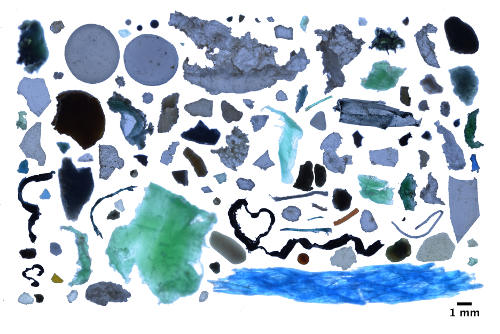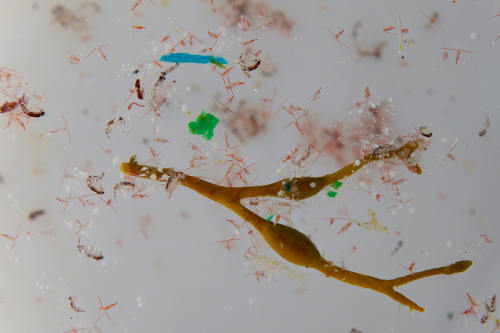Using AI to control energy for indoor agriculture
30 September 2024
Published online 25 April 2017
Trillions of small pieces of floating plastic are coagulating in remote waters near the frozen north.

© Andres Cozar
Extrapolations from net tows scooping the surface of the water behind their schooner indicate that trillions of small, degraded fragments are floating in the area where the seas east of Greenland and north of Scandinavia meet the polar ice caps. The average concentration of the plastic debris is of a similar order of magnitude to the better-known trash gyres of the subtropics.
The expedition's analysis of results was published in Science Advances. It shows the pollution is not a product of the local population, which is tiny in proportion to the amount of waste. Nor is it the sort of plastic that comes from the fishing industry, as it is mostly free of net lines. Instead, it’s waste from northern Europe, the UK and the North America, carried aboard ocean currents to a dead end.
“The Arctic is the motor of global ocean circulation. The sinking of the water in the Arctic near south Greenland sets in motion a global conveyor belt that transports heat, and now we know plastic, across the ocean,” says Carlos Duarte, marine science director at the Red Sea research center at King Abdullah University of Science and Technology (KAUST) and one of 12 scientists participating in the study.
The study concludes that the Arctic floating plastic currently accounts for less than 3% of the global total, but this current will cause plastic to continuously accumulate as pollution from lower latitudes flows upward. The authors say the potential effects of this on the Arctic’s unique ecosystem are especially concerning.
Between five and 10 million metric tonnes of plastic are dumped in oceans each year, previous studies have shown. What floats on the surface amounts to just 1 per cent of this, according to some estimates.
The other 99 per cent, scientists believe, is on the sea floor, on coastlines, or in the guts of animals.
“Plastic in the ocean is an atrocity, but plastic in the Arctic Ocean is particularly harmful. The ecosystem is already under threat from climate change and melting sea ice,” says co-author Erik van Sebille, oceanographer at Ulrecht University, Netherlands. His mathematical modelling used the trajectories of 17,000 GPS fitted drifting buoys as a proxy for the way that plastic moves with ocean flow. In research published five years ago, he correctly predicted the movement of plastics into the Arctic Polar circle, and the Barents sea in particular.

© Anna Deniaud / Tara Expeditions Foundation
In February in Deep-Sea Research I the AWI reported a twenty-fold increase in litter over a decade on the arctic floor at the northern-most station of their Hausgarten deep sea observatory network between Greenland and Svelbard.
The effects of plastic debris on Arctic eco-systems are already present, she says. “More than 80% of the northern fulmars from Svalbard, a sentinel species for plastic pollution because it feeds exclusively at sea, have plastic in their stomachs. Around 6% of the Greenland sharks have eaten plastic. This species was recently reported to live to 400 years of age, which is a long time to collect plastic and be exposed to the toxins associated with it.”
How plastics affect the sediment community on the ocean floor is still the subject of research. “The deep ocean floor harbours a rich and diverse community, rivalling tropical rain forests. If something lies on top of the sediments, it changes the biogeochemistry. It may interfere, so that the sediment-inhabiting community is deprived of food and oxygen,” she says.
AWI robots will sample the floor of the Hausgarten network this year.
The physics of surface ocean currents such as that conducted by van Sebille shows that each ocean basin has its own catchment area for plastic waste. “We all know about the great Pacific garbage patch but we don’t all contribute to it,” van Sebille says.
The newly launched AWI online portal www.litterbase.org provides continuously updated global maps from peer-reviewed publications on litter and its impact on marine life. But says, van Sebille, “We need more research on how plastics affect the Red Sea ecosystem, the Bay of Bengal, the Mediterranean. Everybody’s plastic ends up somewhere else.”
“Plastic pollution is a particular problem here in the Middle East,” Duarte tells Nature Middle East. “Because of poor management practices and high consumption of single use plastics, there is a lot of plastic garbage that is disposed of in the region and it ends up in the Red Sea.”
Duarte’s chief concern is for the Red Sea coral reefs, which filter organisms that ingest this plastic. Eventually this may be redistributed to food webs that are connected to the reefs. Research in the region is ongoing, but underfunded, he says.
Duarte believes replacing plastics with marine biopolymers may be one way of limiting this kind of damage, a project KAUST is exploring. So far in the region only Qatar has this kind of research underway, he says.
“There is a tsunami of plastic coming,” says van Sebille. “In the next five years, we will produce more plastic than in all of the twentieth century. If we can stop that getting into the ocean first, then we can think about cleaning what’s there already.”
doi:10.1038/nmiddleeast.2017.75
Stay connected: